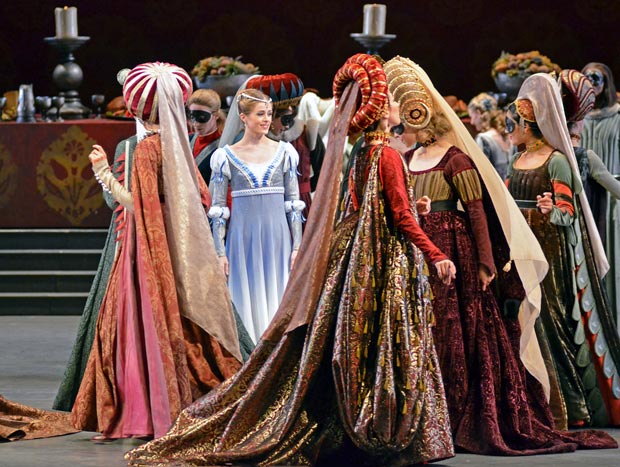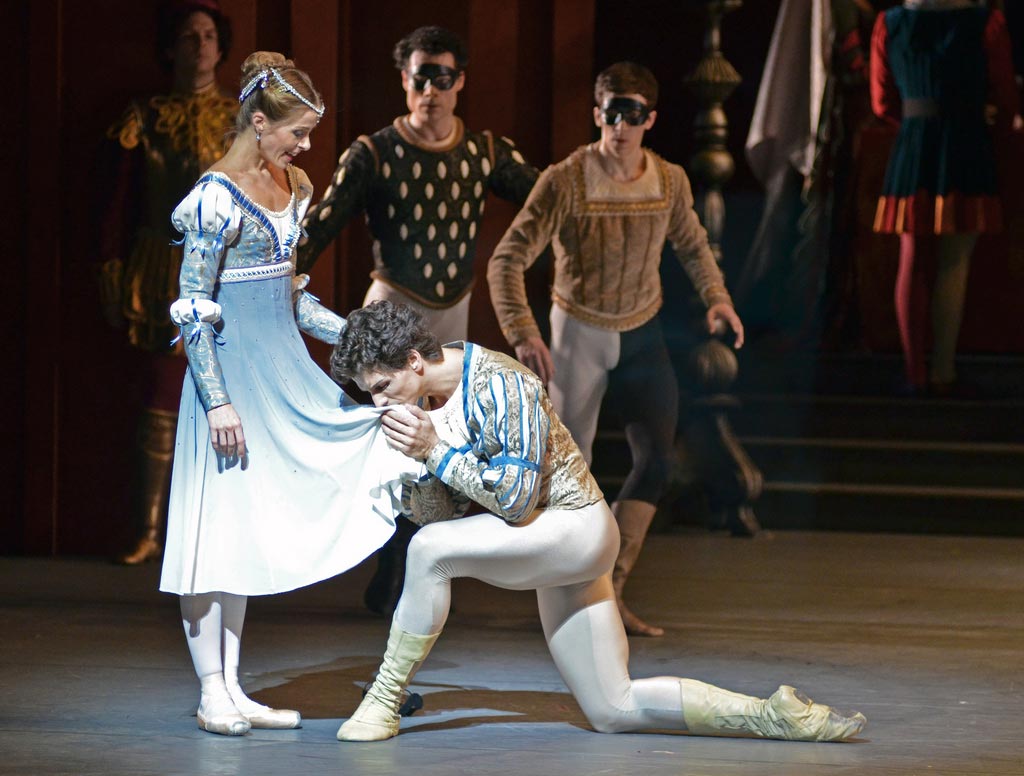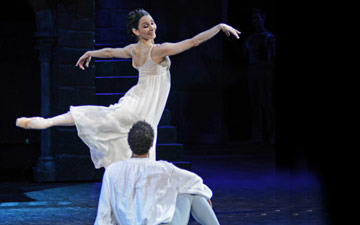
© Dave Morgan. (Click image for larger version)
National Ballet of Canada
Romeo and Juliet
London, Sadler’s Wells
17 April 2013
Gallery of 20 Romeo and Juliet pictures by Dave Morgan
www.ballet.ca
www.sadlerswells.com
Alexei Ratmansky evidently decided that the freshest way to approach Romeo and Juliet was to forefront as many characters as possible rather than concentrating on the doomed lovers. In his 2011 production for the National Ballet of Canada, he fleshes out the roles of Juliet’s nurse, Friar Lawrence, Paris and the Capulet parents, all of whom hold themselves to blame for the joint suicides. Everybody gets the chance to dance.
The result is oddly old-fashioned – even more so than John Cranko’s version, which the Canadians had performed since 1964. The townspeople of Verona execute intricate set pieces, as if expecting applause at the end of each routine. Swordfights are carefully choreographed. Paris does a number on his wedding day rather like Hilarion, that other rejected suitor, being danced to death by batterie. Romeo hurtles around like a whirlwind, in love or in dire distress; Juliet rarely stands still. The slower Prokofiev music becomes, the more steps Ratmansky fits in, determined to prove that this is a tragedy for dancers, not actors.

© Dave Morgan. (Click image for larger version)
He doesn’t define the small-scale society in which the love affair takes place. The locals aren’t colour-coded as Montague or Capulet supporters, though they take sides when fighting erupts. They gather in an empty piazza (no market stalls) in front of a stark, blood-red fort. Designs, by Richard Hudson, are based on Renaissance frescoes, as is the motley assortment of unbecoming costumes. The Capulet ballroom is impressive, with a groaning feast laid out upstage. But it’s odd that the Dance of the Knights involves prolonged swordplay: surely not at a coming-out party among friends and kinsmen. Juliet’s first party is a social disaster, though nobody seems to notice her behaviour with interloper Romeo. He and she run off with each other while Mercutio distracts the guests with his antics. When the pair return for a first pas de deux, every one is eating or exiting, till Tybalt goes berserk.

© Dave Morgan. (Click image for larger version)
The lovers’ key encounter is slightly comic. Having locked eyes downstage, both are lifted high above the crowd – Juliet by Paris, Romeo by his two mates. Romeo makes the running in the ballroom pas de deux, flinging his head back in renversé turns, dizzy with infatuation. Guillaume Coté is an ardent, impulsive Romeo, one of the lads but also a dreamy poet, in love with love. Heather Ogden is a sweet, headstrong Juliet whose swift, clean dancing lacks any particular distinction. When the lovers reveal their feelings in the long balcony pas de deux, she is still sexually unawakened, dancing alongside him. They lie down in the moonlight as if on a beach, not a longed-for bed. Then, after their night together, she’s sad, not desperate at his departure. It’s hard to believe she is already contemplating suicide with a dagger.
The role of the four-poster bed is a curious one. It seems significant from the moment Juliet plays with her nurse on it, her childhood refuge. She returns to it after taking the potion and draws the curtains round her, prefiguring a mausoleum. But she and Romeo have ignored the bed, starting their post-nuptial pas de deux by walking away from it hand in hand, their relationship apparently unchanged. Ratmansky is so determined to avoid the passionate, acrobatic lifts that make the Cranko and MacMillan pas de deux heart-rending that he downplays what ballet can best express. And for all Hudson’s skill in enabling speedy scene-changes, that bed has to be awkwardly pushed off and the stage left dark before the final denouement can unfold.

© Dave Morgan. (Click image for larger version)
Romeo dashes into the Capulet crypt in a flurry of virtuoso leaps and spins, hotfoot from exile. Coté shows that he is a changed man, no longer a giddy boy. But it seems inappropriate that, having drunk poison, he should be able to partner newly-awakened Juliet before collapsing. She had come-to with joy, believing Friar Lawrence’s prophesy, revealed earlier in a tableau with a happy outcome. She swiftly stabs herself to a drumroll. The bodies lie spreadeagled in a turquoise spotlight as their concerned parents arrive. Friar Lawrence is with them, beating his breast. In the gloom, it’s hard to discern who is pleading forgiveness from whom, though reconciliation is assured.

© Dave Morgan. (Click image for larger version)
Ratmansky hasn’t driven a narrative arc through the three acts, moving from the outside world of Verona to the personal tragedy of the young lovers. The scenes are episodic, like his ‘Dances at a Gathering’ ballets for various companies. The corps has a lively time, with two harlots and a band of death’s-head mandolin dancers to animate their activities. Their rhythmical choreography picks out unusual inflections in Prokofiev’s familiar music. Mercutio (Piotr Stanczyk) and Benvolio (Robert Stephen) are irrepressible, bringing off lots of fun steps before Mercutio’s mocking death throes. Tybalt (Jiri Jelinik) is a raging psychopath, Lord Capulet (Etienne Lavigne) not much better. Paris and Friar Lawrence are given too much prominence: who really cares what they feel? Ogden’s Juliet isn’t specific enough as a girl-woman to be involving. We never see her make decisions: she is swept along by Romeo, misled by Friar Lawrence, unlucky in the timing of Romeo’s poison. And though she is ably partnered by Coté’s Romeo, their pas de deux leave no lasting impression. Nor, alas, does this production.

















Romeo and Juliet was my introduction to Shakespeare, an Eng Lit set text. Which came first – Leonid Lavrovsky’s ballet on TV (when the BBC still routinely purveyed culture) – or Trevor Nunn’s production of the play at Stratford, I cannot recall after 40 years. Both, I do remember, were incredibly faithful to the text – and remarkably unengaging for a teenager.
How Franco Zeffirelli had pruned the play for his young lovers, Judi Dench and John Stride at the Old Vic in 1960, I learned only later. Shakespeare’s portrayal of young love and parental control could be dramatically impulsive.
Sergei Prokofiev clearly did not learn that lesson. His score follows the play with literal fidelity. The music illustrates itself – we don’t need a choreographer to visualise it. But all too many choreographers have tripped into Prokofiev’s trap. Having already practiced with Cinderella, Ashton wisely edited the longeurs of R&J – but sacrificed the passion too. Cranko got lost in the market place. Nureyev’s dramatic realism was obscured by his typically fiddly steps.
Helgi Tomasson’s R&J in San Francisco was the version I saw most recently – efficient and obvious – very much in the mould of Cranko and MacMillan. So omnipresent is MacMillan’s version it feels older than its 48 years. However groundbreaking Cranko and MacMillan both were, their dramatic conventions are now obviously dated. The vigour of MacMillan’s ballet has been dulled by constant repetition; its drama has become predictable semaphore.
Not for The Royal Ballet the new broom of Karen Kain at National Ballet of Canada. There another dated giant, Cranko’s Onegin has been renewed in a redesigned production. Cranko’s R&J has left the stage – to be supplanted by new lovers on the piazza. Where other leading choreographers avoid comparison, choosing less familiar subjects for their full-length ballets, Alexei Ratmansky embraces it.
Ratmansky has said he wanted to declutter R&J, purge market vegetables, ballet rhubarb, colour coding design clichés – and to let classical choreography tell the story without mime. So, even without making comparisons, on its own terms Ratmansky’s version disappoints.
Richard Hudson’s designs support Ratmansky’s conception. He was a student of Nicholas Georgiadis, MacMillan’s designer. Hudson’s style is altogether sparer. Particularly effective are the friar’s cloister and tomb scenes. Hudson’s impressively monumental, abstracted sets throw the action into sharp focus.
Hudson’s costumes, in clashing colours, move well – but collar length hair, pork pie hats, skirts and correspondent legs are not an easy look for men to carry off. Paul Andrews’ comparable look for Birmingham Royal Ballet was as unflattering. The patrician Capulet women are better realised, but despite Ratmansky’s wish to avoid colour coding, Juliet’s friends inexplicably all chose the same outfits. Juliet’s party dress is too much a stage costume, grey dégradé dyed and spangled.
Musically Ratmansky choreographs a near-complete score, to his ballet’s dramatic detriment – but perversely at key emotional moments Ratmansky fails to trust the music. Dramatically and emotionally, this is a tepid R&J. The factions in the first scene are undelineated, the killings unmotivated. Replacing Lady Capulet’s flailing grief at Tybalt’s death, Ratmansky gives us a tastefully ordered cortege. He may dispense with flag wavers and sellers of greens in the market scenes – but he still has to rely on cartwheeling masqueraders and harlots to fill the music.
At the ballet’s heart – there is a void in how this Romeo and Juliet talk to each other. Their first meeting in the ballroom is cleverly contrived, the impact on each other mesmerising. But as they dance, the choreography simpers. When Prokofiev steps on the gas, both in the ballroom and under the balcony, Ratmansky does not respond. His choreography does not amplify the flood of emotion in the music.
Dramatically and choreographically there are some striking insights. As the line of guards parts to reveal the dead bodies after the brawl, a girl runs on, horrified at the killing of her kinsman. Could this be Juliet – the moment prefiguring her own fate? (Actually it’s another girl that we see later receiving trauma counselling from the friar, but the incident registers. Juliet when we do meet her in the next scene is typically gauche and remains so – nothing in Elena Lobsanova suggested growing emotional maturity.)
The Benvolio, Mercutio, Romeo masked trio before the ball is delightfully witty – but the length of the number strains Ratmansky’s invention. (Mercutio, as in other R&Js has the best of the choreography, excellently relished by Jonathan Renna – incidentally reminding me of the antics that Nureyev indulged in here when his own choreography was beyond him. McGee Maddox was a beefy, laddish Romeo; he has danced Wheeldon’s Jack in Alice’s Adventures. No other nuances were called for in Romeo’s choreography.)
The gliding circles of Capulet women at the ball, like moths around their sword-wielding men, are telling. The way the men kiss the hems of the women’s skirts acknowledges how the men kneel (perversely) to the women in Lavrovsky’s pillow dance – a gesture inverted by MacMillan whose men force their women to curtsey.
The opening of the third act particularly reveals Ratmansky’s fresh eye – and a different level of imagination that lets this R&J fly. The lovers’ duet in the bedroom for once trusts the music and the emotion of the situation. Romeo’s banishment and Juliet’s imagined reunion with him surge through teeming crowds, as dramatically cogent as the sweep of Massine’s symphonic ballets.
The insistence of the Capulet parents’ that Juliet marry Romeo revealed violence begins at home, no wonder that Tybalt is such a psychopath (an excellent Jirí Jelinek). Ratmansky’s narrative – where Juliet is shown the effects of the poison – is clearer than Nureyev here. But otherwise the act sags, the inevitability of the story obvious but the choreography that tells it is disengaged.
Bravos to the excellent Royal Ballet Sinfonia. Their lightness of touch revealed unexpected details with Prokofiev’s often ponderous score – in tune with Ratmansky’s approach. His characters tend not to dance, but move naturalistically. Romeo bangs his fists in frustration at one point. I felt the same – Ratmansky does not sculpt images that stay in the mind.
Karen Kain astutely recognised her company could earn more money by renting Cranko’s Romeo and Juliet to other companies than performing it – an approach ENB and BRB might consider for their productions of their Nureyev and MacMillan warhorse Romeos. And might The Royal Ballet celebrate the 50th anniversary of MacMillan’s R&J by commissioning a suitably young and radical choreographer to replace it?